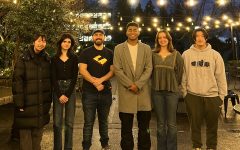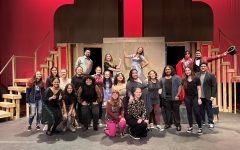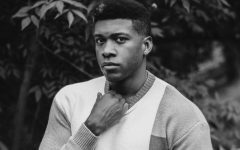Halcyon: An Interview with Diana Majdumar
January 10, 2019 2023-12-13 16:54Halcyon: An Interview with Diana Majdumar
As a child, Diana Majdumar loved watching her father draw. She learned the basics of watercolors from him, and accompanied him to art museums in Estonia (where she grew up), Russia, and Armenia, and was honored to receive as a gift his large set of art books printed in Russian.
After immigrating to the United States, Diana graduated with a Master of Fine Arts degree in drawing and painting from Academy University in San Francisco. There she learned to appreciate and explore different subject matter from traditional landscape paintings and still-life to portraiture. She has studied clay sculpture, charcoal figure drawing, acrylics in mixed media, and, her personal favorite, oil and watercolor painting.
An opening reception for Diana’s show, “Halcyon—Encaustic,” will take place Saturday, Jan. 12, from 7-9 p.m. in PUC’s Rasmussen Art Gallery. The collection of Diana’s encaustic paintings will be on display through Feb. 10, and will be available for viewing every Thursday-Sunday from 2-6:30 p.m. Both the opening reception and admission to the gallery are free and open to the public.
Diana was gracious enough to offer us a glimpse of her world as we prepare to enjoy her work throughout the coming month.
What are encaustic paintings?
Encaustic is basically a beeswax with some damar resin mixed in as a binding element to provide elasticity to the wax, making it less brittle and more long-lasting. In order to apply encaustic, it has to be melted. I use a special electric plate that lets me keep wax melted and hot at a consistent temperature without it getting too hot and smoky or not hot enough. While it is melted it can be applied with brushes one brushstroke at a time like you would with regular paint, except wax starts to harden the second it leaves the hot plate so I have to work fast. After wax is applied it has to be melted on the panel once again; this step is called fusing. This allows for multiple layers of wax to be applied. As long as each layer is fused layer upon layer can be built up.
What is the space like where you work?
My studio is in rural West Petaluma, where we moved six years ago. We fell in love with mature California Coastal oaks and how remote and rustic it feels here, even though we are only few minutes from town. My studio is attached to the back of the garage, away from the house and facing the backyard. I have a few windows and one is very large. My view is of the oaks, a meadow, and a wood stack, but my favorite thing to see out of the window is all the bird activity. In one day, I can easily see up to 20 different kinds of birds: titmice, bushtits, and sparrows in the morning; towhees, crows, and scrub jays later in the day. I usually have my camera handy.
My space is pretty well organized—usually, I know where to find what I need! Though depending on what I’m working on, it can get pretty messy. Especially if I’m just in the collage stages of the process. Lots of boxes and baskets get pulled down from the shelves while I look for the right piece of wallpaper, scrap of fabric, or page from a book.
I’m fortunate to have a studio; not having one for a long time and having to use a corner in the garage instead, I know firsthand what a huge difference it makes to have a special space. And to me it’s not just space for creating art; it’s a refuge—a place I go to first when I get home, a place I go to get away.
What inspired you to become an artist?
It was actually my dad’s dream to become an artist, not mine. In fact, he planned on applying to art school upon graduating high school in Armenia where he grew up, but his parents insisted he pursue a more ‘useful’ profession, and he became an auto mechanic instead. He did some drawing and watercolors, but casually. Years later both my sister and I sat an entrance exam to an art school in Estonia which was the only way to study art with proper instruction. Both of us failed. Only my dad was devastated. From my perspective, getting into that school would mean spending hours with strict, unfriendly teachers (we met few during the exam) after school, coming home in the dark, having to take a couple different trams to get there, and learning art from the basics up, while all I wanted to do is doodle princesses and fairies. My dad’s dreams must have stayed with me, because when I moved to the United States and career choices were in front of me, somehow art was among the options, and I took it.
Every artist has a muse or muses; what inspires your work?
Nature! I know how cliché that sounds, but it’s true! I don’t mean the grandeur of Yosemite Valley or the awesome vistas of the coast. The most mundane and small objects of nature catch my eye and stay with me, like the Queen Anne’s Lace that grows freely on the side of the roads all over Sonoma and Marin. If you slow enough while driving, you will see the white blossoms glowing in the sun in the spring. Now they are brown and have the most interesting shapes.
My painting, “Oak Branch,” (above) was inspired by the impossibly bright leaves on the branch of a fallen oak tree in the Petaluma countryside. It seemed so strange something dead could be so bright, but the saturated yellows and oranges seemed to glow when the sunlight hit them a certain way. I dragged the branch to the side of the road where I was able to take photos of it. The graceful arc of the branch and the colors of the leaves, though dead, is what I tried to capture in the painting.
Who is an artist whose work you enjoy?
My favorite artist is Andrew Wyeth. There are a couple quotes of his that really speak to me; one is, “It’s a moment that I’m after; a fleeting moment, but not a frozen moment.” That captures exactly what I’m trying to achieve in my work. When I paint birds I try and seize a moment in time. How a perfect pair of finches is poised on the branch of the apple tree right outside my window—but just for a second. Of course, I paint from photos—the birds never sit still—but I hope that I can express how lively they are in reality.
In another quote, Wyeth says, “I prefer winter and fall, when you feel the bone structure of the landscape.” Fall and winter and are my favorite seasons as well. I love the sculptural quality of it where you can see shapes more clearly, and the colors are more earthy and intense. Most of my paintings use elements of winter and fall: bare branches of trees in winter, red berries with all the leaves gone, brown leaves of late fall. The color palette of Wyeth’s paintings really resonates with me. At first sight, it might seem limited with its few muddy browns, but if you look longer you see his brushwork—the delicate lines. I especially love his winter landscapes.
What is the meaning of the title of your show, “Halcyon,” and how did you come to choose it?
“Halcyon” has two meanings. First, it denotes a period of time in the past that was idyllically happy and peaceful, and second, it’s a tropical Asian and African kingfisher.
I love unusual words. English is my second language, and I always feel somewhat lacking in my vocabulary. A few years ago when my son had to study for his SAT, I was more than happy to help him with the 200 words that might show up on the test. I still get excited when I hear words like “boon” and “assuage” on the radio.
I especially love words that have anything to do with nature and often use them for the titles of my paintings. I have most of the books by Robert Macfarlane, who travels the countryside of Great Britain and collects the words and sayings that might be disappearing. Several years ago Oxford Junior Dictionary got rid of many nature words such as willow, pasture, and acorn, replacing them with tech-related words. I find that incredibly sad. I say we need more words like “smeuse” which is a gap in the hedge made by regular passage of wild animals, and “zwer:” the noise of the wings of a flock of birds taking flight.









